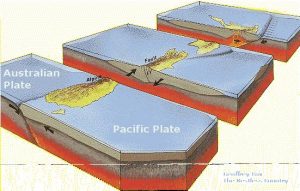Part two of a factual series about the Geology of New Zealand’s Fascinating Island Group – the Marlborough Sound (translated from a report produced by Dr Firouz Vladi, geologist)

Pacific Plate / Australian Plate
Due amount of volcanic activity in this region, one would perhaps expect New Zealand’s North Island (which comprises – to a large extent – a volcanic plateau), to break apart, sink, and ultimately form a rift valley. Two factors are able to prevent this from happening: firstly, the force of magma, which ensures the land mass remains on the earth’s surface, and secondly, the lava and solidified volcanic flue ash (ignimbrite), which fill up depressions during periods of volcanic activity.
Whenever the Pacific plate descends beneath the North Island of New Zealand, it causes the geological formations to suture together. The less dense components rise up as magma to form the region’s powerful volcanoes.
The friction generated by the plates’ movement causes earthquakes to form. The subduction area where the two plates ride over each other is known as the Benioff Zone. In Northern New Zealand, the source of the earthquakes (i.e. the subduction area) is positioned deeper the farther west one travels from the sinking Pacific plate.
The formation of connections between plates is particularly complicated in this region for several reasons:
- Due to lateral movement between the plates along the Alpine Fault
- Because of the subduction of the Pacific Plate over the Australian Plate at the Kermadec Deep Sea Trench (North Island)
- Because of the subduction of Pacific Plate over the Australian Plate at the Macquarie Ridge (South Island) and…
- Because the land in the volcanic triangle around North Island has been torn apart, thus forming the edge of the East Cape.
During the Carboniferous period (362-290 million years ago) huge coal beds were formed on the supercontinent of Gondwana (in what is now Australia). Back then, New Zealand was still an oceanic area – the crustal plate of which gradually moved further and further south. The surrounding sea water was consequently very cold, and the marine life living there had to either adapt or die out. New Zealand’s underwater landscape, which back then was located off the southern coast of the Gondwana continent, included a chain of volcanoes which were very active towards the end of the Carboniferous period.
In the following Permian period (299-251 million years ago) the supercontinent of Gondwana drifted towards another continent, known as Laurasia, before they later merged to form a single continental landmass. This landmass is referred to by geologists as Pangaea (the whole earth).
Stay tuned for more further fascinating information about the formation of the Marlborough Sound including detailed insight about Vladi Private Islands’ founder personal private island – Forsyth – and another favourite of ours: Pohenui Island


